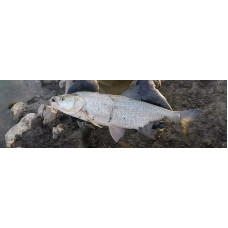Aspius aspius is a semipalmated and freshwater fish of the carp family. The body length reaches 60-80 cm, weight up to 12 kg. It inhabits the basins of the Baltic, Northern and southern seas of our country. Predominantly a river fish. Puberty first occurs at the age of 3-5 years. Fecundity 40-300 thousand eggs. Spawning in spring, eggs are deposited on stony-pebble ground. Predator. Object of sport fishing.
Aspius aspius is distinguished from other fishes by its dark bluish-gray back, silvery-grayish sides and white belly. Dorsal and caudal fins gray, with dark ends, the lower part of the tail is slightly longer than the upper, the other fins reddish at the base and grayish to the end, the head is somewhat elongated, with a prominent upward lower jaw. This fish grows up to 120 cm in length and a weight of 12 kg. But usually the size is 80 cm with a weight of 1.5 - 2 kg. It can live up to 15 years.
It is an inhabitant of plain rivers and avoids water bodies with standing water. It prefers to stay near the surface in the current at the mouths of small rivers and after river crossings. In these places it meets in large flocks. But in places with a weak current, in lakes and reservoirs, it tries to avoid large aggregations.
The young rod feeds on worms, small crustaceans, and insects. However, growing up to 30-40 cm, the stud already becomes a typical predator, eats fish fry, but continues to feed on large insects (beetles, butterflies, dragonflies) and, to a lesser extent, worms. Its teeth are located in the larynx and it feeds on small fish.
In the lower reaches of some southern rivers it leads a semi-passage way of life: in spring it enters rivers for breeding, in summer it fattens up in desalinated parts of the sea, and in winter it lies in the estuary "on the pits". It matures in 3-5 years. Spawning in April - May, usually on stony ground, in places with fast current. Lays from 40,000 to 300,000 eggs.
It is not particularly important from the point of view of commercial fishery, as it does not have outstanding taste qualities and is rarely kept in large flocks. However, it is a popular target for amateur anglers. Especially for spinning anglers.
Aspius aspius
Tags: aspius aspius

